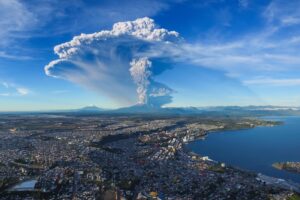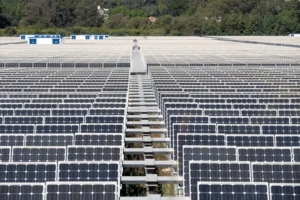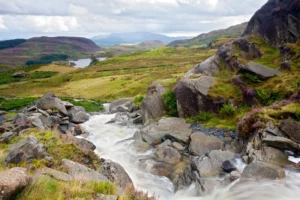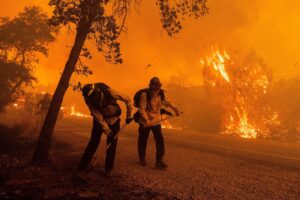
Volcanic eruptions pose fundamental challenges for scientists and their climate models.
It is well known that violent volcanic eruptions can cause sudden drops in surface temperatures, and multiple eruptions can affect climate variability over time scales over decades and even centuries.
When a volcanic erupts inject sulfur dioxide into the stratosphere, an aerosol is formed, blocking sunlight from reaching the earth’s surface.
Unlike human impacts on climate change, the latter occurs slowly and can be considered in climate models in various socioeconomic scenarios. Volcanic eruptions are sudden, which poses challenges in climate prediction.
Scientists are currently unable to predict the time, location, and emissions of sulfur dioxide.
So, how do you consider the impact of volcanic eruptions on the climate when making future climate predictions?

In our recent study published in Communications Earth & Environment, we show that volcanic eruptions have a significant impact on uncertainty in global temperature forecasts.
Our results find that if occasional volcanic eruptions are included in climate predictions, the time to break through the 1.5C warming limit set by the Paris Agreement will be slightly delayed, but at the same time, more periods of rapid warming and cooling will appear in the coming decades.
Volcanic forcing in climate prediction
Climate scientists call the impact of volcanic eruptions on the climate—mainly by releasing sulfur dioxide gas into the atmosphere—called volcanic forcing.
The current climate model uses a constant volcanic forcing value when making future predictions, which is calculated based on the historical average forcing value from 1850 to the present.
The same is true for the International Coupled Model Comparison Program (CMIP), which provides the basic data for the important assessment reports released by the Intergovernmental Panel on Climate Change (IPCC).
However, there are significant limitations in this approach.
First, the historical average forced value cannot represent the occasionality of a volcanic eruption.
Large-scale volcanic eruptions are sporadic – sometimes many events occur concentratedly within a few decades, and sometimes the two events may be hundreds of years apart.
Furthermore, compared with records on the thousands of years scale, there have been relatively few large-scale eruptions—referring to eruptions that emit more than 3 tetragrams of sulfur dioxide—in the reference period from 1850 to the present.
Finally, the volcanic forced reconstruction data used in the early International Coupled Model Comparison Program climate model did not include small and medium-sized eruptions with emissions of less than 3 tg of sulfur dioxide.
This is because most of these eruptions were not detected before the beginning of the satellite era in 1980. However, these smaller but more frequent eruptions contribute 30% to 50% of long-term volcanic forcing.
Take a new approach
Traditionally, climate scientists believe that there are three main sources of uncertainty in climate prediction: internal variability, model uncertainty and scenario uncertainty.
Among them, the “internal” variability refers to the fluctuations naturally occurring within the climate system, such as the El Niño phenomenon; model uncertainty refers to the differences in results between different climate models; scenario uncertainty involves possible global development paths in the next few decades.
Our results suggest that volcanic eruptions should be explicitly regarded as the fourth important source of uncertainty in climate predictions.
To explore how climate predictions change when taking into account volcanic forcing uncertainty, our study adopts a probabilistic approach based on the research proposed by Bethke et al. in 2017.
To this end, we construct a “random forced scenario” that is essentially a possible timeline prediction of 1,000 volcanic activity that continues to the end of this century.
These scenarios are based on the past 11,500 years of history of volcanic activity recorded in the ice core, as well as satellite observations and geological evidence. Each scenario presents a different combination of eruption intensity, location, time and frequency.
(In mathematics, a “random” system refers to a system in which the results contain randomness or uncertainty and are therefore unpredictable; this is contrary to a “deterministic” system, whose results can be fully predicted by initial conditions and a set of rules or equations.)
Subsequently, we used random ignition forced and historical average volcanic forced simulation climate predictions from 2015 to 2100 to study the warming changes under three different emission scenarios in shared socio-economic pathways (SSPs): low emission scenario (SSP1-1.9), moderate emission scenario (SSP2-4.5), and very high emission scenario (SSP5-8.5).
In this step, we use a simplified climate model called FaIR, also known as the “simulator”.
By simulating 1,000 different volcanic futures, we find that climate uncertainty arising from volcanic eruptions in the future of the 21st century may exceed the internal variability of the climate system itself during the same period.
We also found that by the 2030s, volcanic eruptions may account for more than one-third of the total uncertainty of global temperature forecasts.
These results can be seen in the figure below. The impact of different sources on total uncertainty is shown in the figure. The volcano is orange, the internal variability is dark blue, the climate model response is yellow, and the future human emission scenario is green.

Significance of 1.5C critical value
Our simulation results show that the probability of breaking the 1.5C warming upper limit set by the Paris Agreement has decreased slightly in the short term after the possible timeline of volcanic activity is included in the climate forecast.
According to different emission scenarios, the simulation found that the probability of exceeding the 1.5C heating upper limit decreased by 4% to 10% compared to the prediction using constant volcanic forcing.
Although this result may sound encouraging, future volcanic activities will not ease global warming caused by humans in the long run.
The eruption of Mount Tambora in 1815 is a powerful example. The eruption dropped the global temperature by an average of about 0.8C, bringing a “summer-free year” and leading to a large-scale crop failure and famine in Europe, North America and China.
The cooling effect of volcanic eruptions is short-lived and usually lasts only for a few years and does not change the long-term warming trend caused by human emissions.
Our study found that even if multiple possible future volcanic activities are considered, global warming will still exceed 1.5C in all scenarios except the lowest emission path.
Even with frequent volcanic activity in the 21st century, its offsetting effect on global warming only accounts for a small part—which means emission reductions remain critical to achieving long-term climate goals.
The chart below shows the probability of exceeding 1.5C when using random volcanic forcing (solid line) and constant volcanic forcing (dashed line) in three emission scenarios (upper picture), and the probability difference between the two forced modes (lower picture).

Temperature rate on a ten-year scale
Another important finding from our study is that once the variability of volcanic forcing is taken into account, extreme warm and cold decades will be more likely.
In the moderate emission scenario, we find that the probability of a negative decade-long trend—that is, global surface temperatures drop on average over a decade—has increased by 10% to 18%.
Meanwhile, the probability of extreme warming decades also increases, reflecting that the volcanic forcing variability increases the likelihood of extreme warming and cooling events simultaneously.
This result highlights how volcanic eruptions have brought significant fluctuations to global temperature trends on a decade-long time scale.
Moving towards a more complete climate forecast
Understanding the impact of volcanoes on the climate is critical to a comprehensive assessment of the risks faced by agriculture, infrastructure and energy systems in the future.
Running thousands of volcanic scenarios using a comprehensive Earth system model is not practical, as it requires extremely high computing resources. But at the same time, the current approach also has the significant limitations mentioned above.
However, there are still compromises that can be feasible in future climate model work.
The upcoming next-stage climate modeling experiment—the CMIP7 scenario model comparison program—can adopt a more representative “average” volcanic forcing baseline, which incorporates the effects of small eruptions that are often missed in historical records. This bias has now been corrected in the historical volcanic forcing datasets used for next-generation climate model simulations.
In addition, the modeling team should additionally run scenarios containing high and low frequency future volcanic activities to fully capture the impact of volcanic uncertainty on climate predictions.
Although human-induced greenhouse gas emissions remain the dominant factor in climate change, taking into account the uncertainty of volcanic activities properly will help us obtain a more comprehensive future climate map and its potential impact on society.
jQuery(document).ready(function() {
jQuery(‘.block-related-articles-slider-block_20aa77dee136c8d1daf6d951359c4092 .mh’).matchHeight({
byRow: false
});
});
The post Guest Submission: Exploring how volcanic eruptions affect climate predictions appeared first on Carbon Brief.












